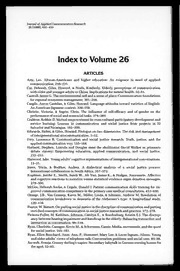
Journal of Applied Communication Research 1998: Vol 26 Index PDF
Preview Journal of Applied Communication Research 1998: Vol 26 Index
Journal of Applied Communication Research 26 (1998), 432-433 Index to Volume 26 ARTICLES Artz, Lee. African-Americans and higher education: An exigence in need of applied communication. 210-231. Cai, Deborah, Giles, Howard, & Noels, Kimberly. Elderly perceptions of communication with older and younger adults in China: Implications for mental health. 32-51. Cantrill, James G. The environmental self and a sense of place: Communication foundations for regional ecosystem management. 301-318. Cargile, Aaron Castelan, & Giles, Howard. Language attitudes toward varieties of English: An American-Japanese context. 338-356. Christie, Victoria, & Segrin, Chris. The influence of self-efficacy and of gender on the performance of social and nonsocial tasks. 374-389. Crabtree, Robbin D. Mutual empowerment in cross-cultural participatory development and service learning: Lessons in communication and social justice from projects in El Salvador and Nicaragua. 182-209. Edwards, Helen, & Giles, Howard. Prologue on two dimensions: The risk and management of intergenerational miscommunication. 1-12. Frey, Lawrence R. Communication and social justice research: Truth, justice, and the applied communication way. 155-164. Hartnett, Stephen. Lincoln and Douglas meet the abolitionist David Walker as prisoners debate slavery: Empowering education, applied communication, and social justice. 232-253. Harwood, Jake. Young adults’ cognitive representations of intergenerational conversations. 13-31. Jones, Tricia, & Bodtker, Andrea. A dialectical analysis of a social justice process: International collaboration in South Africa. 357-373. Kopfman, Jenifer E., Smith, Sandi W., Ah Yun, James K., & Hodges, Annemarie. Affective and cognitive reactions to narrative versus statistical evidence organ donation messages. 279-300. McGee, Deborah Socha, & Cegala, Donald J. Patient communication skills training for im- proved communication competence in the primary care medical consultation. 412-430. Orange, J.B., Van Gennep, Karen M., Miller, Linda, & Johnson, Andrew M. Resolution of communication breakdown in dementia of the Alzheimer’s type: A longitudinal study. 120-138. Pearce, W. Barnett. On putting social justice in the discipline of communication and putting enriched concepts of communication in social justice research and practice. 272-278. Pichora-Fuller, M. Kathleen, Johnson, Carolyn E., & Roodenburg, Kristin E.J. The discrep- ancy between hearing impairment and handicap in the elderly: Balancing transaction and interaction in conversation. 99-119. Ryan, Charlotte, Carragee, Kevin M., & Schwerner, Cassie. Media, movements, and the quest for social justice. 165-181. Ryan, Ellen Bouchard, Anas, Ann, P., Hummert, Mary Lee, & Laver-Ingram, Alison. Young and older adults’ views of telephone taik: Conversation problems and social uses. 83-98. Sacweh, Svenja. Granny darling’s napies: Secondary babytalk in German nursing homes for the aged. 52-65. Journal of Applied Communication Research 26 (1998), 432-433 Index to Volume 26 ARTICLES Artz, Lee. African-Americans and higher education: An exigence in need of applied communication. 210-231. Cai, Deborah, Giles, Howard, & Noels, Kimberly. Elderly perceptions of communication with older and younger adults in China: Implications for mental health. 32-51. Cantrill, James G. The environmental self and a sense of place: Communication foundations for regional ecosystem management. 301-318. Cargile, Aaron Castelan, & Giles, Howard. Language attitudes toward varieties of English: An American-Japanese context. 338-356. Christie, Victoria, & Segrin, Chris. The influence of self-efficacy and of gender on the performance of social and nonsocial tasks. 374-389. Crabtree, Robbin D. Mutual empowerment in cross-cultural participatory development and service learning: Lessons in communication and social justice from projects in El Salvador and Nicaragua. 182-209. Edwards, Helen, & Giles, Howard. Prologue on two dimensions: The risk and management of intergenerational miscommunication. 1-12. Frey, Lawrence R. Communication and social justice research: Truth, justice, and the applied communication way. 155-164. Hartnett, Stephen. Lincoln and Douglas meet the abolitionist David Walker as prisoners debate slavery: Empowering education, applied communication, and social justice. 232-253. Harwood, Jake. Young adults’ cognitive representations of intergenerational conversations. 13-31. Jones, Tricia, & Bodtker, Andrea. A dialectical analysis of a social justice process: International collaboration in South Africa. 357-373. Kopfman, Jenifer E., Smith, Sandi W., Ah Yun, James K., & Hodges, Annemarie. Affective and cognitive reactions to narrative versus statistical evidence organ donation messages. 279-300. McGee, Deborah Socha, & Cegala, Donald J. Patient communication skills training for im- proved communication competence in the primary care medical consultation. 412-430. Orange, J.B., Van Gennep, Karen M., Miller, Linda, & Johnson, Andrew M. Resolution of communication breakdown in dementia of the Alzheimer’s type: A longitudinal study. 120-138. Pearce, W. Barnett. On putting social justice in the discipline of communication and putting enriched concepts of communication in social justice research and practice. 272-278. Pichora-Fuller, M. Kathleen, Johnson, Carolyn E., & Roodenburg, Kristin E.J. The discrep- ancy between hearing impairment and handicap in the elderly: Balancing transaction and interaction in conversation. 99-119. Ryan, Charlotte, Carragee, Kevin M., & Schwerner, Cassie. Media, movements, and the quest for social justice. 165-181. Ryan, Ellen Bouchard, Anas, Ann, P., Hummert, Mary Lee, & Laver-Ingram, Alison. Young and older adults’ views of telephone taik: Conversation problems and social uses. 83-98. Sacweh, Svenja. Granny darling’s napies: Secondary babytalk in German nursing homes for the aged. 52-65. 433 JACR NOVEMBER 1998 Shefner-Rogers, Corinne L., Rao, Nagesh, Rogers, Everett M., & Wayangankar, Arun. The empowerment of women dairy farmers in India. 319-337. Thimm, Caja, Rademacher, Ute, & Kruse, Lenelis. Age stereotypes and patronizing messages: Features of age-adapted speech in technical instructions to the elderly. 66-82. Tracy, Sarah J., & Tracy, Karen. Emotion labor at 911: A case study and theoretical critique. 390-411. Varallo, Sharon M., Ray, Eileen Berlin, & Hartman, Beth. Speaking of incest: The research interview as social justice. 254-271. Williams, Angela, & Coupland, Nikolas. Epilogue: The socio-political framing of communi- cation and aging research. 139-154.
